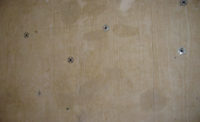Just reading the title of this article gets my blood pumping a little faster. I started out working for my grandfather in his construction company. He had a hard time getting people to do the drywall work, so I taught myself how to tape and eventually went out on my own doing small drywall jobs.
After a few years, I took on a partner and we hired four people and started bidding on drywall projects in developments. It was hard work but I loved it. Eventually, the partnership dissolved but I kept the company and did production work for the next 20 years. As I tired of that type of business, I reduced my number of employees and started doing decorative drywall work, as well as Venetian and clay plaster jobs. I even became a building performance contractor and started air sealing and insulating older homes. When the recession hit in 2008, I became a one-person company for the first time since I went out on my own.

Even small jobs require a lot of tools to complete.
Running a single-person company is not much different than running a larger company. You still have to do careful scheduling, run multiple jobs, line up materials, and meet with homeowners or general contractors. I think scheduling smaller jobs that are not all hanging or taping jobs is the hardest part. I want to fill in each day productively. It is not unusual for me to be applying a decorative plaster finish in the morning and finishing up with some consulting and a blower door test in the afternoon.
I have occasionally taken on hanging and taping a whole house. I will sub out the hanging and do the taping myself but I have found that it ties me down for too long and I have to turn down too many smaller jobs which I really prefer to do anyways. So, I recently decided not to do these larger jobs.

Dust control is always important.
The Difference
The difference is that I have to do everything. This means having to do what I refer to as the $12-an-hour work. If I need another bucket of mud or roll of insulation, I have to leave the job to get it. I also have to do the sweeping up at the end of the day. I would rather just do the $100-an-hour work but that would mean hiring an employee. I have become very good at pricing work because I have done such a variety of work over the years.
I recently did the drywall for walls in a basement being converted to a living space. I did not figure the estimate by the square footage—I estimated my time and added the material cost. The hardest part of the job was carrying the 8-foot sheets of drywall across the back lawn, onto a deck, through the kitchen, and finally into the basement.

It is possible to hang any length of drywall on walls by yourself (HangPro Lift).
In order to increase my actual productive working time, I try and get materials delivered. I stock the basics in my shop. I pick up what I need either on my way to the job or on the way home. I may even turn down or sub out work that has too much $12-an-hour work.
A big thing for me is making the best use of available tools. Ceiling and wall lifts eliminate most of the heavy lifting. I use automatic taping tools where practical. I use a dust extractor that the customers really appreciate. Setting compounds allows me to apply multiple coats in one day. Dehumidifiers and fans are also a big help.
I have always considered myself as being a drywall contractor but just like when I was a larger company, I offer a variety of practices such as priming and painting, air sealing, insulating, any size repairs, and I even do blower door testing and consulting. The difference now is that I work alone. Staying on the job and doing the extras is pretty big for me. Why not offer to prime and paint that ceiling that I just hung and taped? Why not throw out a price on building a tray ceiling for a customer who asked me to price doing some repairs in that room? If I think a wall or ceiling would look great with a colored plaster finish, I make that suggestion.

Passing a blower door test for airtightness is part of the energy code.
A One-Man Show
There are plenty of single or maybe two-person companies out there. Most of us don’t want to hire anyone else and have all the work we need. It’s about being a small or one-person walls and ceilings contractor. I am always reading about how to get employees and how to expand your business. It’s about growing and growing. But what about those of us who are happy with being a small business and have no desire to hire more help? We still want the best tools and are looking for new products and better materials. We are also very good at making money and have found our niche. We also are more likely to be skilled in a variety of practices.
We are in demand, especially if you are working directly for the homeowner. My attitude is that when I am in a customer’s house, I am a guest there. Be polite, on time, neat, honest, communicate, and go above and beyond. You do this and you will have all the work you can handle and can make very good money.

Using colored plaster (Fresco Harmony) is one of the most enjoyable parts of my job.

A framed basement wall ready for drywall.
What I really love about being a one-person company is that I am seldom bidding against anyone. I don’t have to work as fast and as hard as possible to make what I need to (like the production hangers and tapers who bid by sq. ft. and are often low bid on the work). One thing I don’t like is that it usually takes just as many tools to complete a small job as it does for a larger one.
Just today, I was talking to someone while hanging out after a 5-mile trail run. He works for Habitat for Humanity and he knew I was a contractor. He asked me if we could meet over coffee this week to discuss me working with the crews hanging and taping the homes they build. I even mentioned that I could help them meet the new energy code requirements. I would mostly be training and consulting, and I am looking forward to that coffee. W&C










